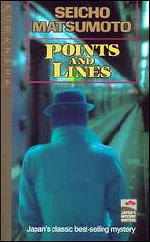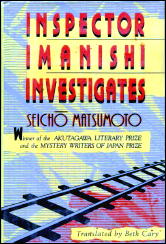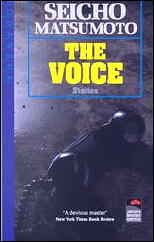Fri 11 Mar 2011
The Mystery Fiction of SEICHŌ MATSUMOTO, by Michael E. Grost.
Posted by Steve under Authors , Reviews[7] Comments
by Michael E. Grost.
1. Ten to sen / Points and Lines

SeichÅ Matsumoto’s Ten to sen (Points and Lines) (1957) is a railway timetable mystery straight out of the Freeman Wills Crofts school. It has such Crofts school features as police detective heroes, plenty of skilled detective work, and plot solutions partly based on the “breakdown of identity.” It is very absorbing reading.
Matsumoto’s story unfolds against the background of a government scandal, involving bribery between businessmen and government officials. This is exactly the sort of situation featured in Akira Kurosawa’s film, The Bad Sleep Well (1960), which makes an interesting cross reference to Matsumoto’s novel. Kurosawa’s treatment is very melodramatic and adventure oriented, whereas Matsumoto focuses on a straightforward realism, never losing focus on the detective work in the book.
Matsumoto’s tales tend to focus on sinister murder conspiracies against the innocent. The conspiracies tend to be worked out in great detail, often involving faked alibis. There is a pleasing sense of mathematical symmetry in Matsumoto’s plots.
2. Suna no utsuwa / Inspector Imanishi Investigates
Matsumoto’s later Suna no utsuwa (Vessel of Sand, translated as Inspector Imanishi Investigates) (1961) combines some traditions in his writing.

The first and better half (Chapter 1 through the middle of Chapter 9) is a mystery story, focusing on solving an obscure murder. It involves such standard Matsumoto devices as an unidentified corpse, railway timetables, and a plot focusing on the two extremes of Japan, the North East and the South West regions of the Islands.
Like Ten to sen, it builds up some interesting geographic patterns in its puzzle plot, patterns that involve the two extremes of the Islands, and which can be traced on a map with almost pure geometric precision and symmetry.
The second half of the book is more of a pure thriller or suspense story, with only a little mystery left. It reminds one of some of the suspense short stories in Koe (The Voice). I like the second half of the book much less than the first, and in general do not enjoy Matsumoto’s thrillers anywhere as much as his mystery stories.
The story also shows Matsumoto’s gift for misdirection. Several times Matsumoto makes it look as if his plot were going one way, only to pull off the opposite direction a few chapters later.
Some of the reviews quoted on the back of Suna no utsuwa occasion some comment. It has become a truism of criticism that police procedural writers are trying to paint a picture of their society, and more than one reviewer duly states this about Matsumoto.
I don’t agree. While Matsumoto is indeed realistic, it is hard to see that he is attempting to build up a systematic picture of Japanese society, Ã la Balzac. Instead, Matsumoto mainly seems concerned with creating mystery plots, together with exploring a few specific subjects that seem to interest him: policemen and their wives, train travel, men with hidden mistresses, bar hostesses, stage and film actors, newspaper reporters, life in South Western Japan, where Matsumoto grew up.
The unnamed reviewer for The Milwaukee Journal compares Matsumoto to Anton Chekhov. This is very true. Matsumoto, like Chekhov, often creates a character by revealing some small aspect of their behavior or personality.
This small piece somehow evokes a whole person, in ways that are mysterious, yet somehow very effective. There is also a low keyed intimacy of tone that recalls Chekhov, at once realistic and sensitive, and a gift for lyrical description of both scenery and everyday life.

3. “Kanto-ku no onna” / “The Woman Who Wrote Haiku”.
The best short story in Koe (The Voice) is “Kanto-ku no onna” (“The Woman Who Wrote Haiku”) (1960). This is a genuine mystery story, not a suspense tale, with a first class plot. It also has the emotionally involving situations one finds in Matsumoto at his best.
The puzzle plot is in the tradition of such earlier works as Wilkie Collins’ The Haunted Hotel (1878), and F. Tennyson Jesse’s “Lot’s Wife” (1929).
4. “The Cooperative Defendant”
Matsumoto’s short story “The Cooperative Defendant” shows his interest in ambiguous situations. As is common in Matsumoto, his detective cannot decide whether his suspect is guilty or innocent. He oscillates between these two positions, based on reasoning about the evidence.
Sometimes he recreates the crime one way in his mind. Then he gets new insight into the data, and reconstructs the crime in a different way. He usually has to really struggle mentally over this, taking a long period of time and much mental effort.
“The Cooperative Defendant” also shows Matsumoto’s fondness for waste spaces: railroad yards, industrial lots, lonely road sides, country areas that are just being built up into cities, deserted beaches are all favorite Matsumoto locales. These are all areas that have some small aspect of human occupation, but which are typically nearly deserted, and almost in their natural state.
There often seems to be water nearby, whether the sea, a famous waterfall, or just a small irrigation pond, as in this tale. Such American pulp writers as Norbert Davis and MacKinlay Kantor also were fascinated by such spaces, although one doubts either had any direct influence on Matsumoto.
Matsumoto’s characters often have complete life histories, something one also finds in Hugh Pentecost. Their various professions can show unexpected links to the murder plot.
Editorial Comments: This essay first appeared on Mike’s website, A Guide to Classic Mystery and Detection. It is reprinted here with his permission.
If I am reading this biography of Matsumoto correctly, the stories that Mike has brought our attention to are only a small sliver of his crime fiction output. Quoting briefly:
“A prolific author, the self-educated Matsumoto did not see his first book in print until he was in his forties. He wrote until his death in 1992, producing in four decades more than 450 works. Although Matsumoto also produced popular historical novels and respected works of nonfiction, it is his mystery and detective fiction that solidified his reputation as a writer at home and abroad.”
Also, if you have it to hand, you might wish to read:
Apostolou, John. “A Yen for Murder: A Look at Japan’s Ichiban Mystery Writer, Seicho Matsumoto.” The Armchair Detective, Vol. 20, No. 3 (Summer, 1987).
March 11th, 2011 at 11:22 pm
Mike, thanks for this one, I only read one novel by Matsumoto, but always meant to read more. I recall being impressed by the orchestration of the details ala Crofts and the somewhat matter of fact approach to the mystery.
Nice to know a bit more about him.
Mysteries have long been a popular genre in Japan, but relatively few have been translated into English. Even today the cultural differences can make it difficult for American readers trying to identify with some rather alien experiences.
Truthfully the genre has always been fairly narrow in that regard — the Brits (and the colonies), a few French writers, a handful of Swedes, and once in a while a Spanish book. I don’t know if it is the problem of translation, the resistance of American readers, or just chauvinism or laziness by the publishers that’s to blame.
Most Canadian writers don’t even make it into the states much less Japanese.
March 12th, 2011 at 5:10 am
As best as one can tell, the above are all the Matsumoto translated into English. If anyone knows of other, perhaps recent books translated, please tell us all. I’ll try to get them at once!
The short story “The Cooperative Defendant†is in the anthology “Ellery Queen’s Japanese Golden Dozen” (1978). EQ’s introduction says that Freeman Wills Crofts is the third most popular Western mystery writer in Japan, right after Agatha Christie and Ellery Queen.
All sources suggest that Matsumoto was the most influential mystery writer of his generation in Japan.
Other people who I’ve lent Matsumoto to, just love him. My sister says he’s terrific. “Points and Lines” is a great place to start.
March 13th, 2011 at 10:26 am
Amazon says that a “new” book by Matsumoto will be published in in English in August. It’s called PRO BONO, and seems to be a legal thriller.
The page has a quote:
“Seicho Matsumoto combines the prolific output of a Rex Stout with the literary qualities of Elmore Leonard.”–San Francisco Chronicle
March 13th, 2011 at 1:33 pm
I have a copy of POINTS AND LINES, and what’s strange is that I even remember what used bookstore I brought it from — it’s up in Deerfield MA. I was intrigued by the comparison to Crofts on the back cover or one of the blurbs on the first pages inside, but alas I have not read it.
Ballantine published a number of mysteries by Japanese writers in the late 1980s, including Shizuko Natsuki and others whose names don’t come to mind right now. I wondered at the time how successful the books were, given the general aversion of American readers to foreign books, or so was my impression. What with several Scandinavian and French writers now doing well — I’m speaking of detective and mystery fiction — and Sujeta Massey is still doing a series set in Tokyo, is she not? — maybe more Japanese crime fiction writers will have their work translated, both older ones and current.
It’s a trend worth hoping for.
March 13th, 2011 at 6:58 pm
It’s funny, because several British and American writers did well with Japanese, Chinese and other foreign sleuths, but for the most part only a handful of writers manage to really make the crossing.
In the case of the Japanese books I do think to some extent the culture shock can be hard on American readers. While I found the Japanese books I read fascinating — both in and out of the genre — it was sometimes difficult to deal with the vast cultural divide.
Perhaps the huge popularity of Anime and Manga will change that and open the American market to more Japanese writers as it has to films.
January 12th, 2014 at 9:06 pm
If I may, I add a few comments.
(1) Japanese TV, on the 100th Anniversary of Matsumoto Seichou’s birth, presented a series of movies made from his stories — at least 20 of them. Some are wonderful. They’re available at a few stores in California.
(2) In his hometown (“Kokuro” in Kyushu) there’s a museum which shows his writing desks and a huge pile of the original manuscripts of his many books, and scenes from the dozens of movies made from his works.
(3) His writing (in Japanese) is newspaper-style, so it is not too difficult to understand, easy to be pulled in.
(4) His people are more interesting than the detective plot, which sometimes seems to rely on coincidence.
(5) I thought about trying to translate some of the stories, but gee — they are so rich with Japanese culture that each sentence would become a paragraph.
“Harikomi” (= “Stake-out”) starts with a sentence that says the detective(s) got
onto a “descending” train at Yokohama station. The translation would have to
explain that “descending” means going away from Tokyo, and that it’s strange
they got on at Yokohama (instead of Tokyo Station) because all the seats would be taken when they got on — they must have had some reason. You see what I mean.
(6) For me the most interesting thing is his images of “evil” lurking in the hearts
of men (to coin a phrase), the villains are not necessarily caught, the good people may be worse than the criminals, long-standing hatreds or emotions can express themselves in sudden crimes, all under the cover of a society that
seems so much like paradise (politeness, safety, modernity, …).
(7) In the books that I’ve read, the detectives are cultured and human.
January 13th, 2014 at 6:08 pm
Richard,
Thank you for the very informative comments!
It would be great if the TV series were shown on US Public TV, with subtitles.I try to read all the Japanese mysteries that are translated, and see as many Japanese films as possible. Japan has a rich culture.
People are annotating older mysteries today. There are versions of Doyle with countless notes. One always manages to learn something new. Victorian England is another world. It might help for Matsumoto too.